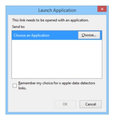
Apple data detectors (x-apple-data-detectors) — How they work and how to use
Today, I received an email from a trusted source which contains links like "x-apple-data-detectors://1". This is the first time I have seen anything like this. Since it looks like a programming-language command or script statement rather than the usual URL or file path+name, I want to make sure that this is safe to activate.
Attached is a screenshot of the dialog that appears in T-bird (v 31.4.0 running in Win 8.1) when I click on the link described above.
What type of application (i.e., wordprocessor, text editor, picture viewer) should I choose to associate with this command/statement? What will happen and what text/data will I get? What will crash?? I don't think I need to see the referenced data/text, but it would be helpful to be able to check to make sure. N.B. — I have found anything beginning with the letter "x" gives me terrible headaches, which makes my inquiry, at least to me, rather important.
A Google search didn't help, returning few links, mostly to Apple web site pages railing against folks stealing their stuff. (Sorry — no pity from me.)
I am well-protected against malware, viruses, etc. by Norton 360 (demonstrated to be quite effective during the last couple of days). Win OS, T-bird, W-Fox, and Norton are all up-to-date.
Many thanks for your help.
Mark Victor
Chosen solution
did you see this http://appleinsider.com/articles/14/04/10/how-samsung-google-teamed-up-to-steal-apple-data-detectors-for-android
or http://www.macosxtips.co.uk/index_files/data-detectors-in-mail.php
X- headers (your not supposed to see headers) are application specific junk, If you look in your mails headers there are probably X-Norton headers. Just as avast puts;
X-Antivirus: avast! (VPS 150209-0, 09/02/2015), Outbound message
Please do not think having Norton on hand protects you. In most cases these days it simply does not scan mail ( it also does not tell you that) see https://wiki.mozilla.org/Thunderbird:Testing:Antivirus_Related_Performance_Issues#Norton_Security
Read this answer in context 👍 0All Replies (1)
Chosen Solution
did you see this http://appleinsider.com/articles/14/04/10/how-samsung-google-teamed-up-to-steal-apple-data-detectors-for-android
or http://www.macosxtips.co.uk/index_files/data-detectors-in-mail.php
X- headers (your not supposed to see headers) are application specific junk, If you look in your mails headers there are probably X-Norton headers. Just as avast puts;
X-Antivirus: avast! (VPS 150209-0, 09/02/2015), Outbound message
Please do not think having Norton on hand protects you. In most cases these days it simply does not scan mail ( it also does not tell you that) see https://wiki.mozilla.org/Thunderbird:Testing:Antivirus_Related_Performance_Issues#Norton_Security

